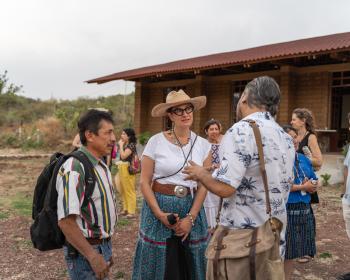On December 8, President Obama signed into law the Claims Resolution Act of 2010, which will award $4.6 billion to Native American landowners and African-American farmers who were wronged by the U.S. Government. This act includes the the $3.4 billion Cobell settlement. The Cobell v. Salazar Indian trust fund lawsuit was first filed in 1996. The plaintiffs wanted justice for mismanagement of Indian land royalties held in trust funds by the Department of the Interior dating back to the 1800s.
There are many who see this settlement as a drop in the bucket, as many will receive less than $2,000 under the plan, which designates a total of $1.5 billion for hundreds of thousands to divide. Almost $2 billion will be allocated for programs aimed at land consolidation of fractionated Indian lands.
In a White House ceremony, the president signed off on Congress’ approval of a settlement to the long-running Cobell v. Salazar Indian trust fund lawsuit. The case was first filed in 1996, and went through numerous court proceedings until last December when the Obama administration announced a deal with Indian plaintiffs.
The plaintiffs had argued for years that the accounting of their royalties held in trust by the Department of the Interior had been inaccurate and mismanaged since the 1800s, resulting in numerous losses for Indian families.
The Obama administration ultimately agreed that a large injustice had been done.
“After years of delay, this bill will provide a small measure of justice to Native Americans whose funds were held in trust by a government charged with looking out for them,” the president said in remarks just before he signed the legislation. “And it represents a major step forward in my administration’s efforts to fulfill our responsibilities and strengthen our government-to-government relationship with the tribal nations.”
Present at the ceremony was lead plaintiff Elouise Cobell – whom the president singled out, noting her work on the case through the years.
“Elouise’s argument was simple: The government, as a trustee of Indian funds, should be able to account for how it handles that money. And now, after 14 years of litigation, it’s finally time to address the way that Native Americans were treated by their government. It’s finally time to make things right.”
Cobell, wearing a bright red outfit, seemed pleased, and smiled when the president shook her hand after signing the settlement into law.
“After 123 years of living with what Congress once called the ‘broken trust,’ people throughout Indian country will see Wednesday as a monumental day,” the Blackfeet Nation citizen said.
“On Wednesday the nation’s political leaders placed their seal of approval on the settlement of our fight in the courts. The successful enactment of the Claims Resolution Act of 2010 confirms that both Congress and the executive branch believe that our settlement is fair and proper – a good deal for all.”
Still, there are many in Indian country who do not see the terms as “a good deal for all.” Much of the concern centers on money, as many class members are expected to receive less than $2,000 under the plan, which designates a total of $1.5 billion for hundreds of thousands of class members to divide.
The plaintiffs had at times argued for a much larger financial settlement, but the leaders of the Cobell team decided that the terms involved in the Obama administration’s offer were the best that could be accomplished without continuing to fight for possibly many more years.
Interior, meanwhile, will gain $1.9 billion to create a program aimed at land consolidation of fractionated Indian lands. Those funds will be issued to Indians who choose to sell their fractionated interests.
Interior Deputy Secretary David J. Hayes said the department is preparing for administration of the funds.
“We will be gearing up for the program. We want to get off to a running start as we look forward to final approval of the settlement.”
Tribal consultation on how to move forward will be one of the first steps, Hayes said.
As Interior prepares, the settlement will go through another approval process – a fairness hearing – under the guidance of U.S. District Court Judge Thomas Hogan. Next, assuming the terms are deemed fair, a media process will occur, notifying beneficiaries. And then it will be sorted out who will receive what.
Many months will likely be needed to get through the judicial processes. The lead plaintiffs have estimated it could take until August before any money flows.
One area of the settlement expected to make waves at the fairness hearing involves lawyers’ fees – an area that caused some Senate members to repeatedly delay supporting the settlement.
As of now, the deal would allow the plaintiffs’ lawyers to receive up to $100 million. The court overseeing the case will ultimately decide the final figure.
Both the Senate and House gave approval to the settlement in November after months of delays.
Interior Secretary Ken Salazar, present at the presidential ceremony, called the agreement “a milestone in empowerment and reconciliation for the nation’s First Americans.”
He said, too, that the settlement is the beginning of “true trust reform.” Along those, lines, he is establishing a Secretarial Commission on Indian Trust Administration and Reform in consultation with tribes.
Interior officials said the commission will undertake an evaluation of how the department manages and administers its trust responsibilities.
“We need to be more transparent and customer-friendly,” Salazar said. “The status quo is not acceptable.”


